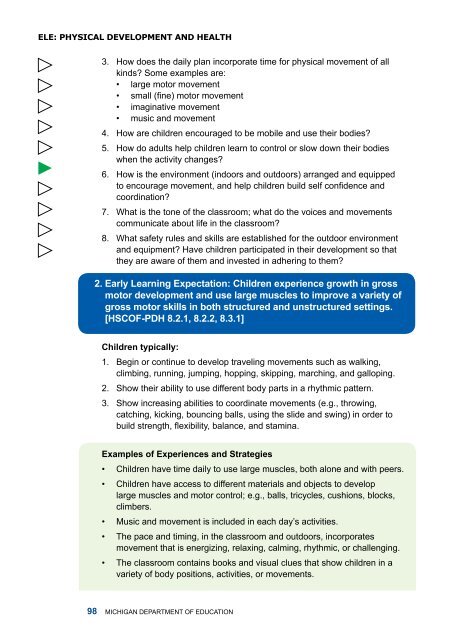Early Childhood Standards of Quality for ... - State of Michigan
Early Childhood Standards of Quality for ... - State of Michigan
Early Childhood Standards of Quality for ... - State of Michigan
Create successful ePaper yourself
Turn your PDF publications into a flip-book with our unique Google optimized e-Paper software.
ELE: Physical Development and Health3. How does the daily plan incorporate time <strong>for</strong> physical movement <strong>of</strong> allkinds? Some examples are:• large motor movement• small (fine) motor movement• imaginative movement• music and movement4. How are children encouraged to be mobile and use their bodies?5. How do adults help children learn to control or slow down their bodieswhen the activity changes?6. How is the environment (indoors and outdoors) arranged and equippedto encourage movement, and help children build self confidence andcoordination?7. What is the tone <strong>of</strong> the classroom; what do the voices and movementscommunicate about life in the classroom?8. What safety rules and skills are established <strong>for</strong> the outdoor environmentand equipment? Have children participated in their development so thatthey are aware <strong>of</strong> them and invested in adhering to them?2. <strong>Early</strong> Learning Expectation: Children experience growth in grossmotor development and use large muscles to improve a variety <strong>of</strong>gross motor skills in both structured and unstructured settings.[HSCOF-PDH 8.2.1, 8.2.2, 8.3.1]Children typically:1. Begin or continue to develop traveling movements such as walking,climbing, running, jumping, hopping, skipping, marching, and galloping.2. Show their ability to use different body parts in a rhythmic pattern.3. Show increasing abilities to coordinate movements (e.g., throwing,catching, kicking, bouncing balls, using the slide and swing) in order tobuild strength, flexibility, balance, and stamina.Examples <strong>of</strong> Experiences and Strategies• Children have time daily to use large muscles, both alone and with peers.• Children have access to different materials and objects to developlarge muscles and motor control; e.g., balls, tricycles, cushions, blocks,climbers.• Music and movement is included in each day’s activities.• The pace and timing, in the classroom and outdoors, incorporatesmovement that is energizing, relaxing, calming, rhythmic, or challenging.• The classroom contains books and visual clues that show children in avariety <strong>of</strong> body positions, activities, or movements.98 <strong>Michigan</strong> Department <strong>of</strong> Education


